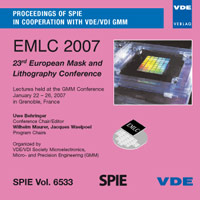Progress in EUV Photoresist Technology
Conference: EMLC 2007 - 23rd European Mask and Lithography Conference
01/22/2007 - 01/26/2007 at Grenoble, France
Proceedings: EMLC 2007
Pages: 9Language: englishTyp: PDF
Personal VDE Members are entitled to a 10% discount on this title
Authors:
Wallow, Thomas I.; Kim, Ryoung-han; Fontaine, Bruno La (Advanced Micro Devices, Sunnyvale, CA 94088)
Naulleau, Patrick P. (Center for X-Ray Optics, Lawrence Berkeley National Laboratory, Berkeley, CA 94720)
Anderson, Chris N. (EECS Department, University of California, Berkeley, CA 94720)
Sandberg, Richard L. (Department of Physics and JILA, University of Colorado, Boulder, CO 80309)
Abstract:
Resist resolution remains a significant issue for EUV. Strong concerns persist regarding the use of chemically amplified resists owing to their diffusion characteristics. Current EUV resist development is focused on a) large-scale screening efforts in an attempt to identify promising platforms and b) refinement and optimization of the processing of these formulations. Resolution arguably remains the parameter of highest importance at this time. The intrinsic resist resolution limit has been claimed to be determined by the resist diffusion length and various metrics have been proposed to characterize this diffusion length as well as resist resolution. Characterization of the intrinsic resolution limit of resists, however, is not a trivial issue due to practical complications such as pattern collapse and top-loss. Here we investigate a variety of resolution and diffusion length metrics and study the correlation between these metrics and observed resist performance when applied to a variety of leading EUV resists. The metrics we study include resist modulation transfer function, corner rounding, through-dose sub-resolution contact printing, iso-focal bias, line-edge-roughness correlation length, and mask error factor. We present an analogous study of resist process refinements. Process refinements are capable of significantly enhancing resolution, expanding process latitude, mitigating resist failure mechanisms, and attenuating line-edge and line-width roughness. Metrics used for correlation of resolution and diffusion length with resist performance show significant utility when applied to process refinement studies as well. Additionally, we show that LWR mitigation can be accomplished in selected EUV resists using post-development surface conditioner rinses. A similar post-development rinse apprach is also demonstrated to reduce pattern collapse at sub-40 nm CDs. Such strategies may become increasingly attractive as CDs shrink toward 32 nm and 22 nm nodes.


